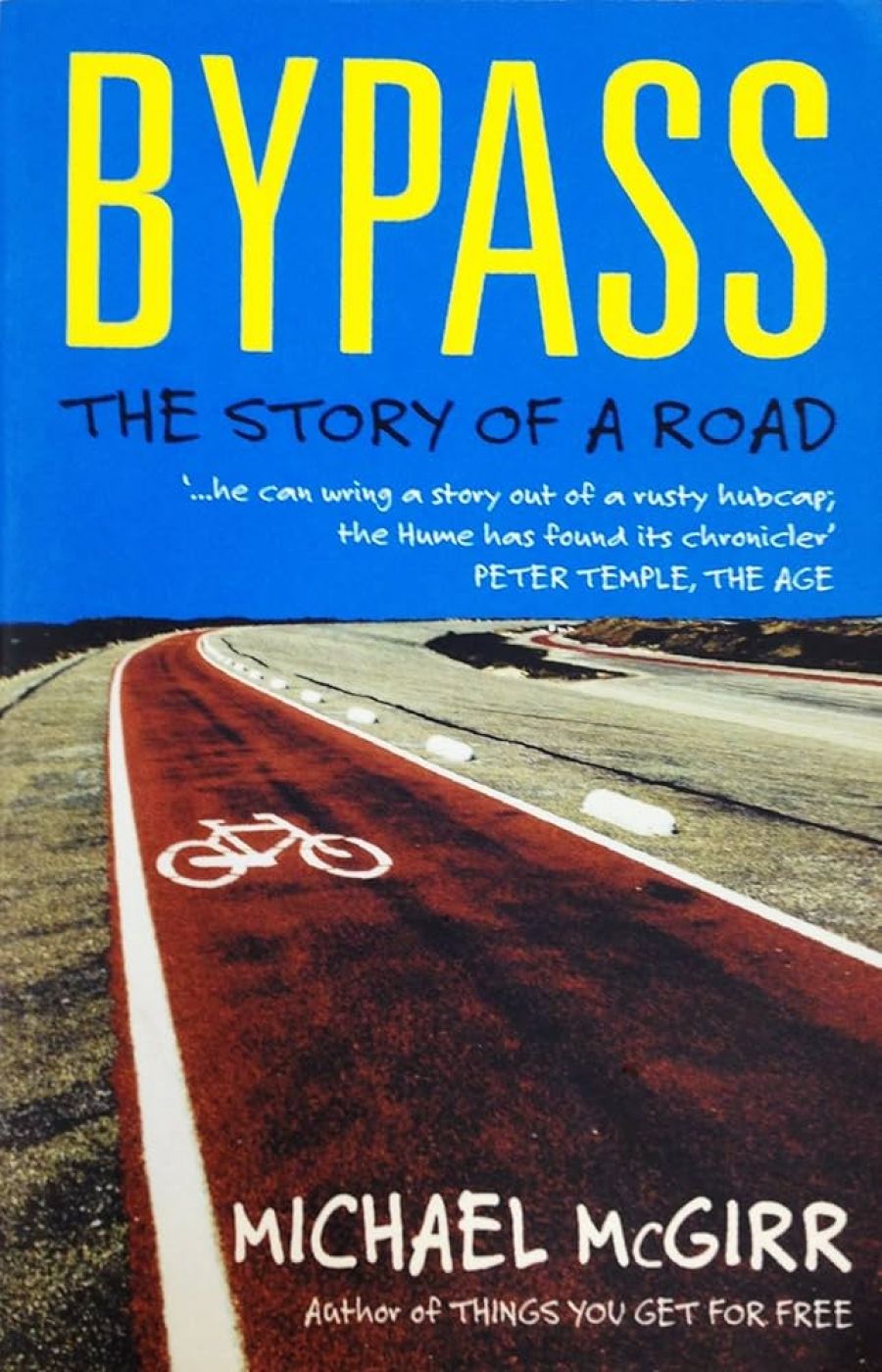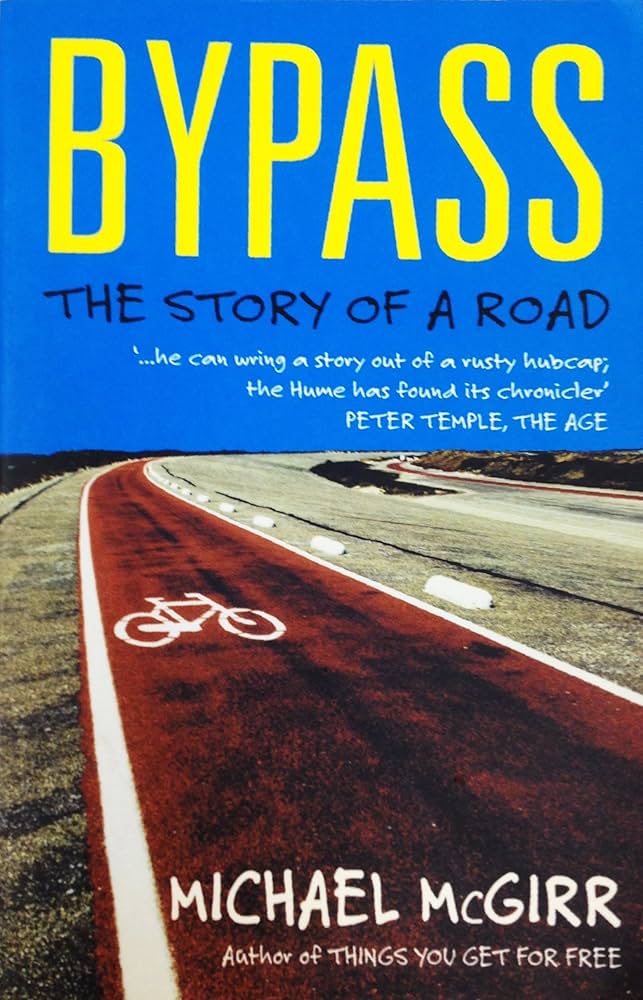
- Free Article: No
- Contents Category: Cultural Studies
- Review Article: Yes
- Article Title: Dragons and Good Men
- Online Only: No
- Custom Highlight Text:
Michael McGirr has an eye for coincidence. ‘The first bypass,’ he notes, ‘was performed on the Hume [Highway] in 1967, the year the world’s first coronary bypass was successfully performed in Cleveland. Though he does not press the point, the comparison is more than a mere curiosity. The conversion of highway to freeway - the steady accumulation of bypasses over the last forty years that has produced by accretion what is now a straight and soulless run between capitals - has also had the effect of preserving and even revitalising the towns along the way. These towns, no longer on the main drag, have to varying degrees weathered the impact of the surgery, recovering identities that had once been obscured by the clogged-up road that ran right through the middle.
- Book 1 Title: Bypass
- Book 1 Subtitle: The story of a road
- Book 1 Biblio: Picador, $30 pb, 313 pp
- Book 1 Cover Small (400 x 600):

- Book 1 Cover (800 x 1200):

The story McGirr tells in Bypass, of travelling the Hume Highway by bicycle from Sydney to Melbourne – accompanied on the second half of the journey by Jenny, his future wife – is also the story of his own recovery from a kind of surgery. He left the priesthood after twenty-one years, and ‘for reasons which I still can’t properly articulate’ moved to the small, bypassed town of Gunning. It is from here that he conceives the idea of the long ride. McGirr makes his way slowly along the Hume, but also back and forth between his own story and the stories of others who have travelled the same road. These stories are told with a deliberate simplicity that reinforces rather than undermines their significance.
Mary Gilmore, for example, who grew up in Goulburn, is described as having done ‘lots of stuff’. Which, to McGirr, isn’t surprising, given that ‘she was born in 1865 and died in 1962, so she had time for it’. The overall effect of this technique could easily have been flip and dismissive, but it is not. Instead. it seems to emphasise the starkness of the lives that have come into contact with this road, and the premium that McGirr clearly places on the capacity to endure stoically, as Gilmore did, whatever may be in store. There is a hint, too, of how he might hope to be read himself when he describes Gilmore as having written ‘some exquisite poetry, the best of it deceptively light’.
Lightness and simplicity can indeed be deceptive. Bypass begins with an account of Cliff Young; a naive, young-old man of near-retirement age who, some twenty years ago, began winning long-distance races and, by doing so, strayed into a brief moment of celebrity. McGirr initially admires Young’s simplicity and his apparent acceptance of the transience of fame; towards the end of the book, he seems to take a different tack, recording Young’s later, unsuccessful attempts to repeat his past successes and to claw back some of that earlier fame, even as he ‘was receding into the twilight of “where are they now”‘. He seems, in this story, to be alerting us to the depths of his own apparent simplicity and innocence, as he does again when he observes knowingly that we all like to find mistakes in books. ‘That’s why,’ he says, ‘I have included so many in this one.’
Bypass begins with an epigraph taken from Lao Tzu: ‘The heavy is the root of the light; the still is the Lord of the restless.’ One- (or two-) liners like this recur throughout the text, introducing chapters and parts of chapters. The usual suspects are here, those like Yeats and Tolstoy who have long done sterling service in the provision of epigraphs. But coexisting with these heavies is the humorous lightness of the bumper stickers that McGirr notices on his travels, and that seem to him to embody an approach to the world that he finds both attractive and sustaining. He makes explicit the connection he sees between the heavy and the light when he observes that ‘Lao Tzu, whoever he, she or they may have been, lived too early to write bumper stickers, which is a pity because Lao Tzu had a natural talent for the genre’.
This fondness for the epigrammatic, bumper-sticker approach to the world is evident in the text itself: ‘The traveller writes about home,’ he says at one point; and, right at the beginning, ‘you don’t come to a small town to hide. There are cities for that.’
Even the people he meets along the road have the same way of speaking; laconic, ironic and epigrammatic. ‘So much effort,’ says a man he meets who has taken on the self-appointed task of documenting the history of Ford car production in Australia, ‘goes into preserving the future.’ Like the wisdom of Lao Tzu and the bumper stickers, the voice of Bypass is not attributable to an individual so much as to a way of life, a preference for paradox or what McGirr calls ‘riddles’, rather than for ‘maps’. It is a very Australian voice, one that is both simple and complex at the same time.
McGirr recalls the comment made to him by a truckie friend who had been on the road for thirty years, when he was asked what it was that had kept his marriage alive. ‘He immediately said, “Honesty”.’ The banality of this answer strikes a false note, as does McGirr’s response to it. He highlights its simplicity, and goes on to comment that ‘maybe this is why I believe in bumper stickers as the medium of the future·. Maybe. But what seems to appeal to McGirr about bumper stickers is not so much their simplicity – a bumper sticker that said simply ‘honesty’ would surely have us searching for just where the irony lay – as their brevity, their capacity to capture in only a few words that characteristically Australian combination of the sentimental and the hardedged, the idealistic and the pragmatic. ‘I believe in dragons and good men,’ says one bumper sticker, ‘and other creatures of fantasy.’


Comments powered by CComment